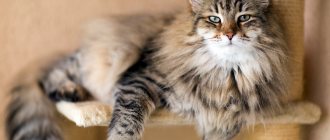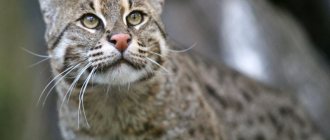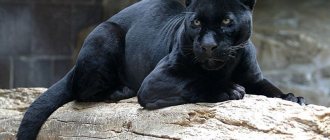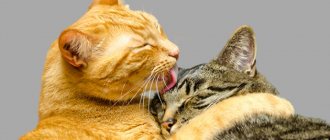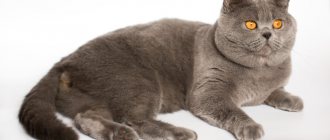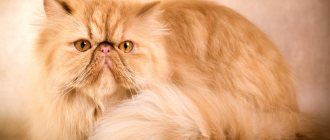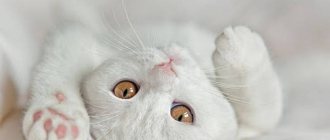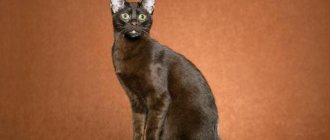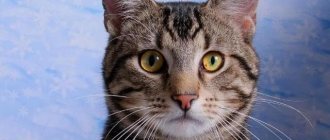WCF standard
The body
is muscular, of medium size, strong, flexible, dense, of medium length.
Tail
rather long, pointed, thick at the base.
Limbs
sinewy, long and slender. The paws are narrow and oval.
Head
wedge-shaped, medium proportions, soft contour, a slight notch at the transition to the muzzle is desirable. When viewed from the front, the muzzle is rounded and fits into a parabola, pointing downwards. Strong chin, medium length nose. The profile is without a stop, but not straight either, the forehead is slightly convex. Graceful neck.
Ears
large, widely and vertically set and wide at the base. The tips are rounded, with a “thumb print”, tassels on the ears are desirable.
Eyes
large, shiny, expressive, almond-shaped. Wide apart, slightly oblique (the outer corners of the eyes are higher than the inner ones). Color - pure, clear, juicy amber yellow or green, with eyelid rims.
Wool
short, thin and tight-fitting. Double or triple ticking. Dark ends of hair are preferred.
Flaws:
White spots, white medallion, too much white on the chest, closed necklaces, gray or too light undercoat, too little ticking, moire stripes. Pattern/stripes on the face or limbs. In dark colors there is no dark tip of the tail, dark “soles” on the hind legs, or dark rims on the eyelids.
Siamese type, round head, small or pointed ears, round eyes, mixed eye color, too noticeable feet.
| Body: 20 points Head, ears: 15 points Eyes: 10 points Color: 25 points Ticking: 15 points Texture: 10 points Condition: 5 points |
Colors:
Wild color, sorrel, blue, beige fawn, tortoiseshell, tortoiseshell sorrel, blue tortoiseshell, tortoiseshell fawn, black silver, sorrel silver, blue silver, fawn silver, blue tortoiseshell silver, tortoiseshell fawn silver
Feeding and caring for Abyssinian kittens
For those who do not like to spend a lot of time caring for their pet, an Abyssinian cat is ideal. Short hair will not burden the owner with long-term combing out of tangles or daily brushing, as required by the coat of long-haired cats.
global $ads_google; //data-ad-slot=”2475549904″ $ads_google = empty($ads_google) ? false : true; ?> if ($ads_google == false) {?> $ads_google = true; ?> } ?>
You can take care of the fur once a week - just brush the kitty with a brush with metal teeth and also bathe it during the molting period.
A scratching post installed in the house will solve problems with claw sharpening. Otherwise, you will have to give your cat a manicure on your own once a month. In order for a cat to allow his nails to be trimmed calmly, he is taught this process as a child.
Once a week, the ears are examined, which should be cleaned with a damp cloth, and the eyes; if necessary, they are wiped with a clean damp cloth.
Keeping such cats requires proper feeding—the quality of the food determines the pet’s health and appearance. An Abyssinian kitten is able to get used to the offered diet and not be mischievous.
Up to a year old, a growing kitten is offered food designed to meet the needs of each month of the baby's growth.
The Abyssinian breed needs wet and dry food. If you want to feed your pet natural products, they give preference to meat. It is better to boil the meat and offer it in pieces, but sometimes you can simply pour boiling water over it.
A cat can start breakfast with fermented milk products and porridge. Among the representatives of the breed there are ardent adherents of a vegetable diet - you should not deny your beloved cat such a whim.
n 25 WILD COLOR (RUDDY)
Color:
Body color is warm brown with black ticking.
The base of the hairs is dark orange, the belly and inner sides of the limbs are also dark orange or dark apricot, in accordance with the base of the hair on the rest of the body. The darker shade along the back forms a “wild” line. The tip of the tail and the "soles" of the hind legs from the pads of the feet to the hock joint should be rich black. Nose:
brick red with black edging.
Paw pads:
black.
Buy an Abyssinian kitten
The cost of an Abyssinian kitten remains consistently high: the price consists of the value of the breeding line, care for the cat during pregnancy and childbirth, care for growing kittens, their vaccination, nutrition and maintenance for the quarantine period after vaccination.
Full care and impeccable pedigree can only be provided on a contractual basis by specialized nurseries for breeding the Abyssinian breed. Third-party sellers, as a rule, cannot guarantee such conditions. The purity of the baby’s blood, his exhibition qualities and state of health are also questioned.
Kittens that will not take part in breeding in the future are 2-2.5 times cheaper than the same breed-class cats. Valuable breed lines are always sold with a ban on breeding. Externally, castrated and sterilized cats and female cats do not differ from their counterparts; they also take part in exhibitions in their categories.
The average price for an Abyssinian is 30,000-50,000 rubles
.
What to name an Abyssinian cat
Kittens receive their names, where the surname, or the prefix to the name, bears the name of the cattery. Most likely, at home you will want to name the cat differently, but the name given by the breeders will be written in the pedigree.
global $ads_google; //data-ad-slot=”2475549904″ $ads_google = empty($ads_google) ? false : true; ?> if ($ads_google == false) {?> $ads_google = true; ?> } ?>
In general, most often babies are given nicknames associated with anything: the appearance of pets, flowers, literary characters, the names of ancient pharaohs and geographical places. No one will deprive the owner of the right to name his favorite furry boy or girl, because whatever you name the ship, that’s how it will sail. But it should be understood that the name indicated in the metric will appear at the exhibition. To name a cat as your heart desires, you should agree on this with the breeder in advance. And names offered for the Abyssinian cat !
Name table
| Girl | Boy | ||
| Britney Bayra Adetta Lasta Hannah Gabby Credit Jucha Asta Iskra Rina Arleta Gotha Troya Safari | Bobbin Bast Shani Nut Munya Milana Lara Feri Ali Nut Eva Kusya Fanya Zhulya Korra | Charles Bridge Nathan Otto Cent Amon Tim Best Emir Sam Tormund Eraser Benu Silver Alf | Adis Archie Tutan Mike Pate Lexus Mouse Amber Sherlock Dust Argo Spot Zlatan Forex Charlie |
b 25 SORREL (RED)
Color:
The body color is a brilliant copper-red with red-brown ticking. The base of the hairs is dark apricot, the belly and inner sides of the limbs are also dark apricot, in accordance with the base of the hair on the rest of the body. The darker shade along the back forms a “wild” line. The tip of the tail and the “soles” of the hind legs should be red-brown.
Nose:
Pink with red-brown edging
Paw pads:
Pink
Purchase
To buy a real Abyssinian kitten, it is better to contact a nursery. An adult animal, due to its attachment to its owner, is less tamed. At two months of age, the kitten is ready to separate from its mother, but breeders prefer to give them away at the age of 12-16 weeks, when they best adapt to their new family.
When choosing, you should pay attention to its external characteristics: how healthy the skin, coat, and mucous membranes are. There should be no damage, scratches, scabs, or rashes anywhere. A healthy animal shows activity and curiosity, the stomach is not bloated or sunken.
The cost will depend on the following factors:
- Class – “show” (exhibition version), “breeding” (for producing offspring), “pet” (pet).
- Purity of parental lines.
- Reputation of the nursery.
- Color. For the rarest blue the price will be higher.
The average price, depending on all components, varies from fifteen to eighty thousand rubles.
Photo gallery of Abyssinian cats:
ns 25 BLACK SILVER
Color:
The base of the coat is pure white with black ticking.
A slightly darker shade along the back forms a line, it should appear especially dark. The tip of the tail and the "soles" of the hind legs from the pads of the feet to the hock joint should be rich black. Nose:
Brick red with black edging
Paw pads:
Black or brownish-black
Eye color:
Green or bluish-green, green preferred, with black edging.
Nutritional Features
Kittens of these breeds are not cheap, there are health issues, and in general you should only buy premium or super premium food if you prefer dry food. They will provide the animal with all the necessary elements and vitamins. Your cat should always have clean water available. Abyssinians have a narrow jaw, so the food must have small pellets.
When choosing food, take into account:
- age;
- condition - weight, health;
- whether there was castration;
- restrictions from veterinarians;
- allergic reactions.
Kittens up to 1 year of age feed exclusively on mother's milk. Eating natural food imposes additional troubles on the owner, because the diet must be balanced and safe.
bs 25 SORREL SILVER
Color:
The base of the coat is pure white with red-brown ticking.
A slightly darker shade along the back forms a line, it should appear especially dark. The tip of the tail and the "soles" of the hind legs from the pads of the feet to the hock joint should be a rich red-brown. Nose:
Brick red with brown edging
Paw pads:
Cinnamon or chocolate
Eye color:
Green or bluish-green, green preferred, with brown edging.
as 25 BLUE SILVER
Color:
The base of the coat is pure white with steel blue ticking.
A slightly darker shade along the back forms a line, it should appear especially dark. The tip of the tail and the "soles" of the hind legs from the pads of the feet to the hock joint should be a rich steel blue color. Nose:
Brick red with blue edging
Paw pads:
Bluish-gray
Eye color:
Green or bluish-green, green preferred, with black edging.
cs 25 FAWN SILVER
Color:
The base of the coat is pure white with warm cream ticking.
A slightly darker shade along the back forms a line, it should appear especially dark. The tip of the tail and the “soles” of the hind legs from the pads of the feet to the hock joint should be a rich, warm cream color. Nose:
Pink with dark pink edging
Paw pads:
Dark pink
Eye color:
Green or bluish-green, green preferred, with black edging.
Note: Any shade of cream or brown in the undercoat is a fault on all silver varieties.
Reviews from Abyssinian owners
There are a wide variety of reviews on the Internet - from negative to positive. Let's look at a few of them.
Julia, owner of the Abyssinian Sorrel:
“Our cat is hyperactive. She doesn't sleep much, so she has to be locked in a separate room at night. This is probably the only negative on her part. Otherwise, she has become a good friend to me and tries to be near me all the time.”
Nikita, owner of a wild-colored Abyssinian:
“A very temperamental pet. He often shows his character, especially when I pay little attention to him. Once I tried to transport it in a special transport bag. A couple of days later the bag was torn. Apparently the cat didn't like her. When he’s bored, he loses his appetite, so I try not to leave him alone at home.”
CFA Standard
GENERAL CHARACTERISTICS:
The general impression of the ideal Abyssinian is an elegant medium-sized cat with an original color and royal dignity. The Abyssinian is flexible, strong, muscular, energetic and inquisitive in all conditions. This is a well-balanced cat both physically and emotionally.
HEAD:
A modified wedge with rounded outlines - all lines and planes have smooth transitions and contours. The transition from the forehead to the nose is pronounced, the forehead is full, wide between the ears and smoothly blending into the neck.
MUZZLE:
rounded, without pinch. The chin is wide and should not be slanted or protruding. Adult cats have more developed jaws.
EARS:
alert, large, moderately broadly directed, broad and cupped at the base, open. The hair on the ears is short and fine, with clear, contrasting ticking.
EYES:
almond-shaped, large, shiny and expressive. Neither rounded nor slanted. The eyes are outlined with a dark line surrounded by a light tone.
BODY:
medium length, flexible and graceful, the muscles are well defined, but not prominent or coarse. The body structure is between compact and elongated. Proportion and balance are more important than size.
LEGS and FEET:
proportional, graceful, the Abyssinian seems to stand on his toes. The paws are compact, small in size and oval in shape. Toes: five in front and four in back.
TAIL:
thick at the base, gradually tapering towards the tip.
WOOL:
soft, silky, original texture - dense and elastic to the touch, shiny. Medium length, close to the body. Hairs with zonal coloring - two or three colored rings alternating with a lighter tone.
FLAWS:
elongated or narrow head. Dark colored rings on the legs, open necklaces on the chest and stripes on the tail. Cool or gray shades in color. White undercoat in blue and fawn colors.
DISQUALIFICATION:
white medallion, or white anywhere except the chin and eye rims, tail defects, closed necklace on the chest, gray tone at the base of the hair throughout the body, any black hairs on the red coat, incorrect number of toes. Unrecognized color.
Abyssinian color:
The coat color is warm and luminous. The original color is formed by hairs with contrasting stripes, bright even at the base of the hair. The base color is bright and clear, a deeper tone is desirable, a darker stripe along the ridge is allowed unless it is very contrasting. Preference is given to animals without patterns on the lower part of the body, legs and tail. On the muzzle there are dark lines around the eyes and eyebrows, on the cheekbones, shading and dots on the underarms. The eyes are outlined with a dark line, surrounded by light glasses. Eye color - gold or green, monotony and depth of color are encouraged.
Wild color:
black on red-brown tone.
Red:
chocolate on a red background.
Blue:
blue on a beige tone.
Fawn:
cocoa color on a light beige tone.
Silver
- all of the above color variations on a silver tone (not recognized).
All colors: Nose
- pink with a liner in the color of the main color;
Paw pads
- dark in the color of the main color.
| Head (25) Muzzle………. 6 Head……….. 6 Ears………… 7 Eye shape……. 6 | Body (30) Body………. 15 Legs and paws .. 10 Tail ……….. 5 | Wool (10) Texture…….. 10 | Color (35) Color……….. 15 Ticking…….. 15 Eye color….. 5 |
History of the origin of the Abyssinian cat breed
global $ads_google;
//data-ad-slot=”2475549904″ $ads_google = empty($ads_google) ? false : true; ?> if ($ads_google == false) {?> $ads_google = true; ?> } ?> It is not only man who leaves a mark on history. Many cat tracks stretch from Abyssinia, or today's Ethiopia. This is one of the versions that explains the origin of this interesting graceful breed. There are also mentions of Abyssinians in the kingdom of Ancient Egypt. It is believed that these cats became the prototype of the goddess Bastet - a woman with a cat's head. There is an opinion that representatives of the Egyptian branch did not survive to this day, and today's beauties are only the result of the hard work of British breeders.
The first Abyssinian cat set foot on the shores of Great Britain in 1868, and just 3 years later the beautiful Zula was exhibited at the Crystal Palace. A year later, Abyssinian cats were talked about in the media. In 1874, a book by Gordon Stables was published, dedicated to the varieties of cat breeds, which already contained information about new cats.
12 years have passed since the Abyssinian pussy came to England, and the breed gained public recognition. They decided to consolidate and improve the qualities by crossing with a British shorthair cat.
After this, the popularity and prevalence of the Abyssinian cat in Europe and America began to grow rapidly. The first breeding cats and cats had a silver color and the remainder of the pattern in the form of stripes.
Silver-colored cats were discovered in America in 1907, but this color was not recognized by felinologists there, and in the 1920s there were almost none left in England. During the Second World War, cat populations declined greatly and recovered at a very slow pace. Even in 1978, after the feline leukemia epidemic, there were no more than a dozen manufacturers in England.
In the 21st century, the appearance of the breed has changed: the size of the animal has changed, the ears have grown, and many new colors have appeared. Today, Abyssinians are loved and popular all over the world.
Colors according to TICA standard
Ruddy:
Orange-brown, covered with two or three stripes of black or dark brown. The upper lip is darker, with orange-brown skin. The outer part of the body is covered with shorter hair and should have at least one ticking stripe. Dark shading along the spine is allowed if it is fully ticked. The inside of the body, chest, inside of the legs should be red-brown without ticking, medallions or spots. Color variations range from apricot to deeper, with deeper flowers being preferred. The tail should be black with no rings or gray spots. Paw pads are black or dark brown with black between the toes. Eye color - gold, green, copper or gazelle. Richer and deeper tones are preferred. The nose is brick red.
Sorrel (Cinnamon):
The appearance is orange-brown with red ticking and chocolate brown. The tail is chocolate brown. Deeper sorrel (cinnamon) colors and richer ticking are preferred. The paw pads are pink with brown between the toes. Eye color - gold, green, copper or gazelle. Richer and deeper tones are preferred. The nose is pink.
Blue
A warm, soft raw blue with darker blue ticking. The base hair, lower body, chest, inner legs are cream. The spine is a darker shade than the body color. The tail is a darker shade of blue. Good full ticking is preferred. The paw pads are lilac-blue with blue between the toes. Eye color - gold, green, copper or gazelle. Richer and deeper tones are preferred. The nose is dark pink.
Fawn
A warm pink-beige with a powdery effect, ticked into a deeper, darker pink-beige. Base hair, lower body, chest, inner legs are fawn. The spine is a darker shade than the body color. The tail is a darker shade of pink-beige. Good full ticking is preferred. The paw pads are lilac-pink with pink-beige between the toes. Eye color - gold, green, copper or gazelle. Richer and deeper tones are preferred. The nose is lilac-pink.
Conclusions about the breed
What can an Abyssinian cat conquer? This breed is delightful for its appearance, smooth lines of a strong healthy body, and pronounced affectionate and sociable character.
A person who brings an Abyssinian into the house will immensely love such a smart and interesting cat, because she manages to find a common language with both the child and other pets.
This wonderful breed has good health, amazing silky hair and does not burden the owner with excessive demands on grooming.
NBC colors. Review
Silver cats only have an undercoat that differs from tabby cats, with four ticking colors that are the same for both species. In all silver variations, the preferred undercoat color is white. The ticking matches the color of the coat and gives the overall appearance of a silver color. An ivory undercoat is also acceptable. Yellow or brown spots on the chest, belly, or inside of the legs are not desirable, although they are not considered a fault.
Silver: The ticking or dark stripes on the coat are black. The undercoat is white and silver. The tail is completely cinnamon color without rings. Eye and pad color: same as Ruddy. The nose is pink.
Silver-Cinnamon The ticking or dark stripes on the coat are the color of cinnamon. The undercoat is white and silver. The tail is completely black without rings. The color of the eyes and pads, as well as the nose: the same as Sorrel.
Blue-Silver: The ticking or dark stripes on the coat are blue-gray. The undercoat is white and silver. The tip of the nose and the color of the spine are like Blue. The color of the eyes and pads, as well as the nose: the same as Blue.
Fawn Silver: The ticking or dark stripes on the coat are fawn colors (pink beige).
The undercoat is white and silver. The tip of the nose and the color of the spine are like Fawn's. The color of the eyes and pads, as well as the nose: the same as Fawn. Abyssinian cat standards https://abyssin.net/wp-content/uploads/2016/03/cat10.jpg https://abyssin.net/wp-content/uploads/2016/03/cat10.jpg2018-10-08T22:35 :47+03:00 abyssinAbout the Abyssinian breed articlesWCF standard The body is muscular, medium size, strong, flexible, dense, of medium length. The tail is quite long, pointed, thick at the base. The limbs are sinewy, long and slender. The paws are narrow and oval. The head is wedge-shaped, of medium proportions, soft contour, a slight notch at the transition to the muzzle is desirable. When viewed from the front, the muzzle is rounded and fits into a parabola, pointing downwards. Strong...abyssinPhilip Sirotin [email protected] Cattery
Habits and character of Abyssinian cats
The characteristic behavior of cats can be different, but in the case of the Abyssinian cat, its character completely corresponds to its appearance. Just by looking at this graceful perfection, its playfulness and curiosity become apparent. These same character traits and at the same time amazing balance will not allow the cat to interfere excessively in the owner’s life, although the pet will not object to the manifestation of care from a loved one.
Both adults and children will enjoy the cat's sociability: they are affectionate and at the same time independent creatures. In order for an Abyssinian cat to honor its owner with its trust, judging by the reviews, the training process should not include harsh shouting, and it is even more unthinkable to use physical force.
How to litter train an Abyssinian kitten
The owners who keep an Abyssinian cat claim that this is a true, loyal friend. The animal is responsive to affection and pays in kind. These pets do not like loneliness. Although they do not get in the way of their household members, they nevertheless feel more comfortable knowing that their beloved owners are in the apartment nearby. Cats love to participate in family events, their natural curiosity pushes them to do so. This is partly why they willingly join in children's games; they do not need energy.
The favorite of the whole family is ready to get along with other pets: the Abyssinian kitten will happily add both a cat and a dog as friends, and will win this friendship with its kind character.
Abyssinians are smart and can be trained. Pretty soon they can already bring a small object to the owner. The habits of the animal and its desire to spend time actively will help with this. Well-mannered cats behave well during the exhibition, which invariably makes their owner proud.
